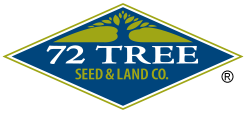Notice: Undefined variable: page in /home/vrxdg1855sn3/public_html/wp-content/themes/72tree/content.php on line 15
Notice: Trying to get property 'ID' of non-object in /home/vrxdg1855sn3/public_html/wp-content/themes/72tree/content.php on line 15
Can We Live Without Trees and How to Save Them

Without trees, we all die. Besides providing oxygen for us to breathe, trees make life on earth sustainable. Discover what is happening to the world’s trees and why we urgently need to stop senseless deforestation.
Trees affect everything from the air we breathe to the rain that falls from the sky. Without a robust population of trees, we die and so does our planet.
72tree.com gathered tree information, statistics, problems, and actions we can all take to preserve our trees and our habitable planet.
What Will Happen if We Cut Down All the Trees?
Right now, just over 3 trillion trees are growing on our planet. Every year, over 15 billion of those trees are felled or lost to natural disasters. At this rate, earth’s last tree will fall in roughly 200 years.
As earth’s tree population nears zero, the following will occur:
Oxygen and CO2 – Trees remove CO2 from the atmosphere and convert it to oxygen through the process of photosynthesis. Without them converting CO2 to oxygen, CO2 levels would begin to rise while oxygen levels would steadily fall.

Trees are responsible for 35% of the oxygen we breathe. The other 65% are produced by algae and phytoplankton in the oceans.
Flooding and Erosion – Without tree roots to absorb water and stabilize the soil, even the smallest of storms will result in significant flooding, topsoil erosion, and landslides.
Air and Soil Pollutants – Trees work nonstop to filter ammonia, sulfur dioxide, nitrogen dioxide, and carbon monoxide from the air and soil.
Without trees, these pollutants would find their way into what crops are left and into the feed of what animals are left, not to mention the air we breathe.
Evapotranspiration – Without trees, the process of evapotranspiration would stop. This is the process of moistening the air which produces more clouds. Evapotranspiration is responsible for maintaining the delicate balance between fertile land and dry desolate desert.
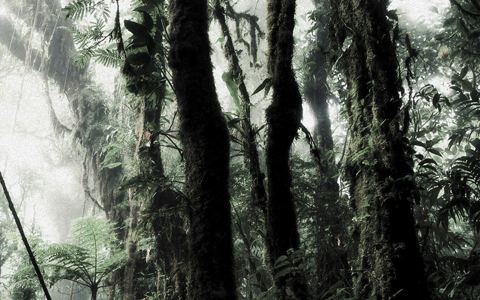
Fewer clouds mean less rain. With less rainfall, fertile land would dry up, fresh water sources would run out or stagnate, and agriculture will begin to fail on a global scale.
Acid Rain – Without trees to remove pollutants, what little rainfall remains would be mostly acidic. All remaining plant life would be crippled.
Global Warming – As the earth’s temperatures rise, the polar ice-caps would melt at an accelerated rate, causing ocean levels to rise and inundate coastal lands and freshwater sources.
As witnessed primarily in the south pole, the ice caps are already receding at an alarming pace, and if this melting isn’t slowed or stopped, it could threaten the survival of all wildlife within that ecosystem.
As the ice melts and causes desalinization in the oceans, weather patterns are subject to erratic change. Off-season snow storms, tsunamis, typhoons, hurricanes, and even blistering summers can all be driven by our raising global thermostat.

Labored Breathing – With CO2 levels on the rise and oxygen levels depleted, people with respiratory and blood problems would be the first to die along with animals unable to cope with the atmospheric changes.
Extinction – Small animals which once depended on trees for food and shelter would be the first to perish. Within a short period, the natural food chain would begin to lose its structure, leaving carnivorous scavengers to likely last the longest.
As temperatures continue to rise, the oxygen levels in the atmosphere decrease, and food sources become even more scarce, the food chain – in its entirety – would eventually break down, leaving every living creature on the planet on a collision coarse with extinction. Including mankind.
The timeline and events portrayed above are a representation of the first fifty to one hundred years without trees.
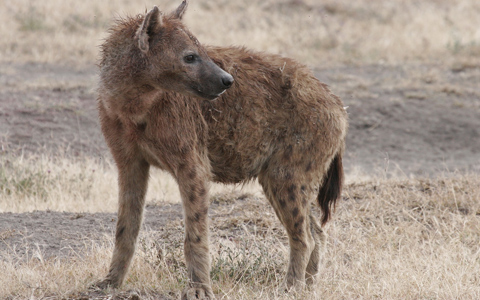
What Can We Do to Stop Deforestation?
You alone can make a tremendous impact on the future of our planet’s tree population. The following are ways that you can help stop deforestation:
Plant a Tree – Every tree you plant slows down the effects of deforestation. However, planting a tree isn’t enough. It is just as important to keep that tree healthy and resistant to disease and insect infestation.
Adding to the complexity of this situation is the process of natural deforestation. This is when beetles and other boring insects successfully attack large numbers of trees in either urban settings or forests. As these trees die, they dry out and become fuel for wildfires.
Besides annual inspections of your trees, whenever you detect the presence of an infestation or disease, call an arborist to assess the situation and offer a course of action.
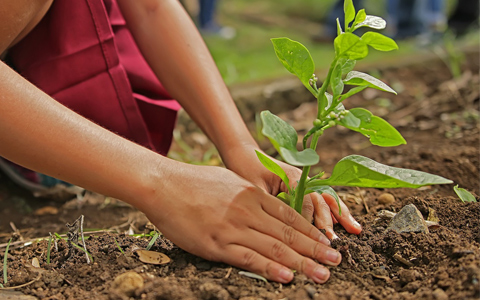
you can discover more about tree health problems and solutions by visiting 72tree.com/9-common-tree-health-problems-solutions/
Go Paperless – Whenever possible, receive and pay bills online. With the technological advances we have at our fingertips, we are able to reduce the use of nearly all paper products drastically.
Recycle – For decades, companies and households of all sizes have been recycling. You can push this concept forward by only purchasing recycled paper products and by recycling yourself.
Look for Forest Stewardship Council Certification – This is known as FSC certification and can be found on wood, paper, and food products. Products with this certification are produced in sustainable ways and can be classified as follows:
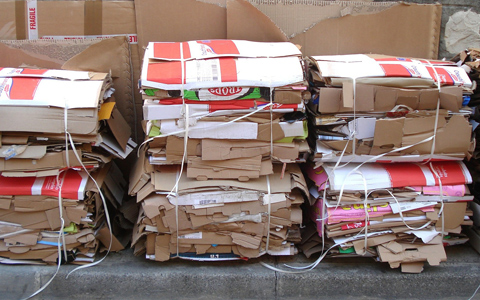
• FSC 100% includes products that come from FSC-certified forests.
• FSC Recycled means the wood or paper within a product is sourced from reclaimed material.
• FSC Mixed means at least 70 percent of the wood in a product comes from FSC-certified or recycled material, and that 30 percent is made of controlled wood.
Eat Vegetarian – By eating vegetarian or vegan meals as often as possible, you are reducing the demand for livestock, thereby reducing the need for deforestation to graze the animals.
Teach Others about Sustainability – The most impactful thing you can do to save our trees and forests is to teach others how to live sustainably.
According to recent research, nearly half of the world’s trees have been lost over the past 12,000 years to agriculture and population growth, and at the rate trees are currently being cut down, they will be gone in 200 years unless we take action to prevent it.
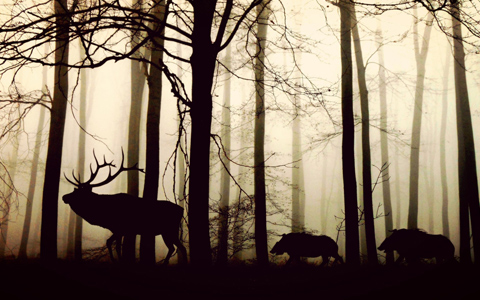
What Can We Do to Save Trees
As mentioned above, planting a tree helps turn back the effects of deforestation, while saving trees is a bit different. To save a tree, you don’t necessarily need to travel to the forest and stand in the way of a bulldozer.
You can save trees every day by caring for the ones that surround you:
• Plant trees in their hardiness zone.
• Plant trees in locations where they can grow freely.
• Adjust soil conditions to match your trees’ needs.
• Prune your trees as it grows.
• Water your trees during dry weather.
• Learn to identify signs of disease and infestation.
• Schedule annual inspections by an arborist.
• When a tree becomes a hazard, have it removed.
That last bullet point may have confused you. There are times when tree diseases or infestations can pose a grave threat to the surrounding ecosystem. In such cases, removing the tree may be the only practical option to protect other trees.
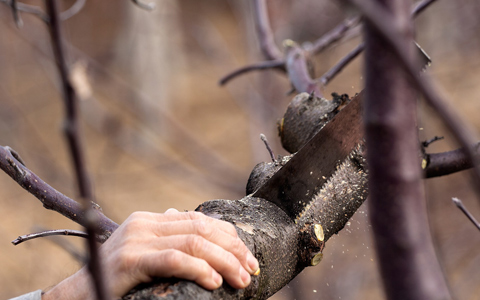
Cutting Down Trees Affects Us and Our Environment
All living creatures including mankind need trees to breathe, eat, and live. Life on earth, at all levels, depends on the abundant existence of a healthy tree population.
In this article, you discovered important tree population information, statistics, problems, and actions we can take to care for our trees and keep our planet habitable.
Ignoring that there is a problem only allows the problem to flourish. If we are to preserve our planet, each of us must take action in some way to keep our trees healthy and rely less on the material possessions that encourage deforestation.
Sources:
https://blogs.worldbank.org/opendata/five-forest-figures-international-day-forests
https://www.epa.gov
https://www.greenpeace.org/usa/forests/solutions-to-deforestation/
https://www.ucsusa.org/global-warming/solutions/stop-deforestation
https://ic.fsc.org/en/what-is-fsc-certification
https://www.nature.com/articles/nature14967
Notice: Undefined variable: page in /home/vrxdg1855sn3/public_html/wp-content/themes/72tree/content.php on line 15
Notice: Trying to get property 'ID' of non-object in /home/vrxdg1855sn3/public_html/wp-content/themes/72tree/content.php on line 15
Tulip Tree Information, Problems, and Care
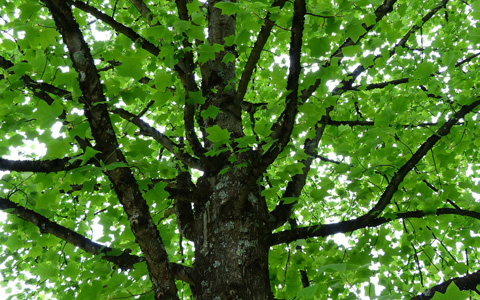
Liriodendron tulipifera also known as tulip poplar is neither tulip nor poplar. This species is a relative of the magnolia tree and is unbelievably easy to care for.
A native North American species, L. tulipifera is the state tree of multiple states, unique in its rapid rate of growth, and exceptional in its beauty. The tulip tree should be strongly considered for mid-sized and large landscapes.
72tree.com gathered tulip tree information, problems, care tips, and answers several frequently asked questions.
Tulip Tree Information
Liriodendron tulipifera is a blooming tree species native to eastern North America. The tulip tree is among the tallest of the eastern US species, is long-lived, and a favorite specimen tree in landscaping.
Tree Name – Yellow poplar
Scientific Name/Species – Liriodendron tulipifera
Family – Magnoliaceae
Genus – Liriodendron
Nickname(s) – Tulip tree, tulipwood, American tulip tree, tulip tree, tulip poplar, whitewood, and Oonseentia (in the native Miami-Illinois language).
State Tree – Indiana, Kentucky, and Tennessee.
Lifespan – Can live up to 500 years or more when planted in optimal conditions.
Type – Deciduous.
Hardiness Zone(s) – from 4 to 9
Soil Requirements – Prefers well-drained, slightly acidic, moist, rich, and fertile soil with full sun exposure.
Planting Spacing – 35ft between trees.
Watering Requirements – Regular when young or planted. Minimal thereafter.
Height – 80 to 100ft on average (can reach nearly 200ft under optimal conditions)
DBH – 4 to 6ft.
Crown Span – 30ft or more at maturity (can be conical or oval in shape).
Root Spread – Yellow poplar roots will tend to match the growth of the tree. If the tree is 100ft tall by 40ft wide, its roots will likely grow 100ft deep and 40ft wide. In some cases, the roots may extend much farther outward in search of water.
Uses in Landscaping – A magnificent specimen, screen, or large shade tree, and is better suited for more spacious landscapes.
Winter/Fall Colors – Yellow before leaf-drop in the fall.
Tulip Tree Problems
Healthy tulip trees are incredibly resistant to insect infestations and disease. However, when your tree is stressed by drought conditions, soil compaction, soil nutrient depletion, or poor pruning, insects and diseases can successfully attack it.
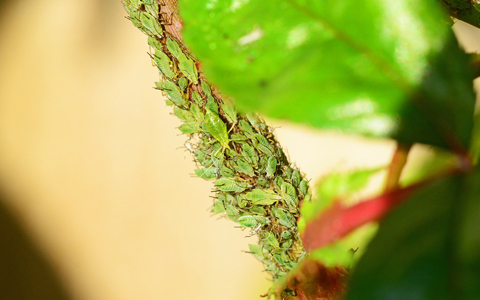
Pests – Tuliptree scale, yellow poplar weevil, and aphids, in the spring and summer months.
Disease – Powdery mildew, verticillium wilt, and canker.
Major Disease Threat – Verticillium Wilt
Symptoms of Verticillium wilt are premature foliar chlorosis and necrosis, and discoloration in both stems and roots. Symptoms of wilting become more apparent on warm or hot days.
This pathogen attacks a potential host by colonizing its roots and spreading throughout the roots, trunks, and stems. Due to this, one of the best forms of disease management is to encourage the healthy growth of your tree.
Tulip Tree Care Tips
There isn’t much you will need to worry about as long as your tulip tree is:
• Within its hardiness zone (4-9).
• Growing in partial shade to full sun.
• Planted in moist, well-drained soil with a pH of 3.7 to 6.5.
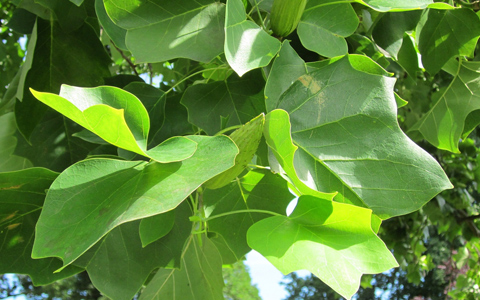
Pruning should be done once the tree has entered dormancy in late fall and early winter. However, when cankers are detected, prune out the affected area including the canker (all the way to the trunk if needed).
If the canker is located on the trunk, or when other irregularities are detected, call on a professional tree service or arborist to evaluate the tree and offer guidance.
People Also Ask
Question: Are tulip tree roots invasive?
Answer: No. If they are planted far from structures, walkways, or driveways, and the roots are readily able to absorb moisture.
Answer: Yes. As with all tree species, the purpose of roots is a never-ending quest for water and nutrients. When they are deprived, they will spread, and make their way underneath foundations and other structures.
For more on the destructive capabilities of tree roots, read 72tree.com/tree-roots-buckling-concrete-driveway/
Question: What is tulip poplar wood used for?
Answer: Lumber from tulip poplars is commonly used for fencing, siding, flooring, and some furniture.
Question: Can poplar wood be painted?
Answer: As this wood has a particularly straight grain, paints adhere to it quite well. Stains, on the other hand, have a tendency to blotch and usually require that a conditioner be applied before application.
Question: Is poplar as strong as oak?
Answer: No. While considered to be a hardwood, the fast growth rate of the tree produces a softer/weaker wood making it easy to work with.
Question: Do tulip trees bloom every year?
Answer: Yes. However, this species only produces its first blooms after nearly 20 years of growth. Thereafter, it will bloom annually in late spring or early summer.
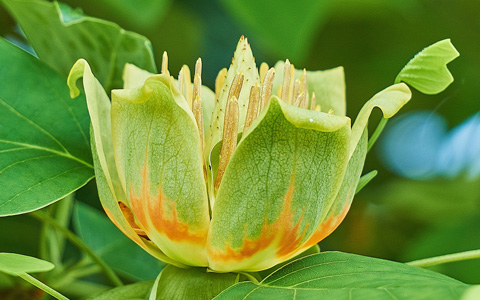
Question: Are tulip trees messy?
Answer: Yes. Like all deciduous tree species, they lose their foliage in the fall. If subjected to drought conditions, tulip trees may drop their foliage prematurely in late summer. Not to mention that when the tree blooms, the flower petals will litter the ground around the tree.
Question: Can tulip trees be planted in Georgia?
Answer: Yes. The entire state is within the required hardiness zone for healthy tulip tree growth. For more on this and other great landscape trees, read 72tree.com/5-popular-alpharetta-ga-shade-trees/
Liriodendron Tulipifera is a Perfect Landscape Specimen
Although sometimes called “tulip” or “poplar,” or both, the Liriodendron tulipifera is neither of the two. This magnificent relative of the magnolia rapidly grows tall and full, making it highly desirable as a landscape specimen tree.
In this article, you discovered tulip tree information and specifications, its problems, how to care for them, and answers to frequently asked questions.
If the tulip tree isn’t a part of your landscape, you are missing out on a fast growing and beautifully shaped shade or screen tree. They are easy to plant and require minimal care efforts.
Sources:
https://extensiongardener.ces.ncsu.edu/extgardener-tulip-poplars-for-large-and-small-landscapes/
http://ipm.ucanr.edu/PMG/GARDEN/PLANTS/tuliptree.html
https://extension.psu.edu/tulip-poplar-diseases
http://www.apsnet.org/edcenter/intropp/lessons/fungi/ascomycetes/pages/verticilliumwilt.aspx
http://hort.ufl.edu/database/documents/pdf/tree_fact_sheets/lirtula.pdf
Notice: Undefined variable: page in /home/vrxdg1855sn3/public_html/wp-content/themes/72tree/content.php on line 15
Notice: Trying to get property 'ID' of non-object in /home/vrxdg1855sn3/public_html/wp-content/themes/72tree/content.php on line 15
Preventing and Eliminating Christmas Tree Bugs
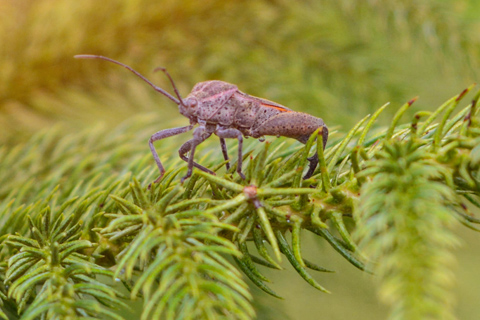
The Christmas tree is the pinnacle of holiday decorating but can also be a nightmare when bugs hitch a ride on the tree into your home.
Infested Christmas trees present a series of problems for the homes and neighborhoods they decorate. Pest control and prevention are essential measures when putting up a live tree for the holidays.
72tree.com collected information on the bugs that can be found on Christmas trees, how to prevent the buying of an infested tree, eliminating any insects found on the tree, and how to properly dispose of the tree.
Bugs on Christmas Trees
When you go to your local Christmas tree lot, keep in mind that just a few days prior, those trees were cut down from a Christmas tree farm or a forest.
Insects may have nested in or laid eggs on these trees. The following are some of the insect species you may encounter living or hatching in your Christmas tree:
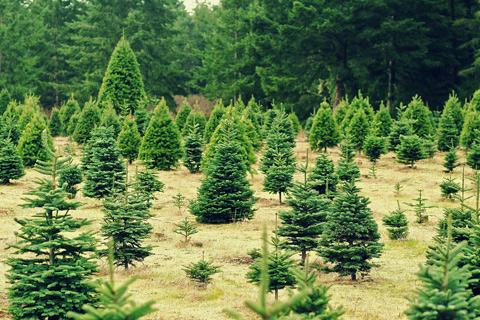
• Aphids
• Spiders
• Bark Beetles
• Mites
• Scale
• Needle Scale
• Mantises
• Spotted Lanternflies
• Sawfly
• Adelgids
• Stink Bugs
Note: Store-bought wreaths and swags made from live tree stems may travel thousands of miles from where they originated (potentially exposing your ecosystem to a new or invasive insect species). During the manufacturing and packing processes, bugs and the eggs they lay can easily be overlooked.
How To Prevent Bugs on your Christmas Tree
You can prevent bringing bugs into your home on a Christmas tree by following a few easy steps:
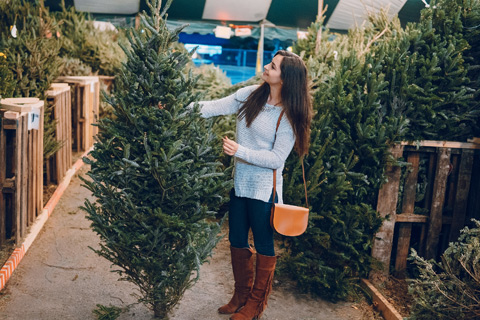
Right Time to Shop – Do not shop for a Christmas tree at night. It is easier to spot insects and eggs during the daytime.
Inspect the Under Side of Branches – Lay the tree down and get an up-close look at the underside of the branches and the trunk. Pay particular attention to the lower branches. You are looking for:
• Visible Insects
• Red or Brown Dots (Mites)
• Clusters of Eggs (Mantises and Lanternflies)
• What Appear to Be Snowflakes (Adelgids)
• White or Red Dots on Needles (Scale)
• Brown Cocoons (Sawfly)
• Small Holes in Trunk (Bark Beetle)
• Sawdust Trails (Bark Beetle)
Let It Stand – Attach the base and let the tree stand in the garage for a day or two. As a preventative measure, apply neem oil or insecticidal soap to the tree before moving it inside and decorating it.
How To Get Rid of Christmas Tree Insects
One of the most common insects found on Christmas trees is aphids. Killing aphids and other insects can be accomplished by spraying the tree with non-toxic neem oil or a homemade insecticidal soaps. Read more about killing aphids.
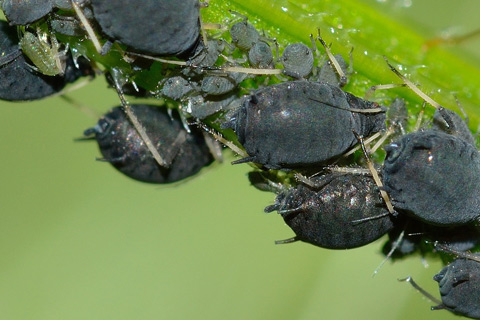
For the most part, newly hatched insects and spiders quickly expire from desiccation (they dry out). However, there are those that do survive.
Beetles, mantises, spotted lanternflies, and sawflies can leave the tree and potentially make their way outside. Again, the application of neem oil and insecticidal soap can be used to control these insects.
If you spot insects or eggs on your tree, DO NOT use commercial aerosol bug sprays. There is no necessity to expose yourself and your loved ones to these harsh chemicals. And, as many of them are flammable, you risk having the tree and your home go up in flames.
For pests that have fallen to the floor or are on your furniture, avoid stepping on them or crushing them (they can leave stains, and some insects have a putrid smell).
Use a vacuum cleaner that doesn’t have a beater bar to suck them up. Then treat the bag or the receptacle with neem oil or insecticidal soap before disposing of them.
How To Dispose of a Christmas Tree
To help preserve the ecosystem in your region, avoid placing the used tree on brush piles or compost heaps. Invasive insects and diseases are able to escape into landscapes and neighboring forests, becoming established, and upsetting the native ecosystem.
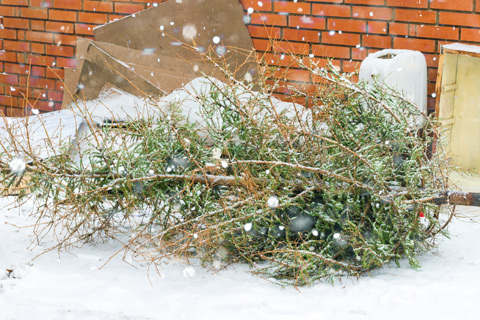
When you take steps to properly purchase, treat, and dispose of a Christmas tree, these risks are dramatically reduced.
Many municipalities and counties nationwide have pickup programs established to retrieve your tree at curbside and properly dispose of it.
If you miss this service or it isn’t available, you can take the tree to a solid waste facility, dump, or landfill. This will keep any pests that may remain in the tree from spreading.
Bug-Free Christmas Tree for the Holiday Season
An infested Christmas tree inside your home probably wasn’t on your wish-list for this holiday season. When bugs hitch a ride into your home, you need to know how to handle them efficiently.
From this article, you have discovered which bugs can be found on a Christmas tree, what to look for when purchasing the tree, how to eliminate any bugs on the tree, and how to properly dispose of the tree once the season is over.
Your home, neighborhood, and neighboring forest are all at risk when the poor management of a Christmas tree infestation allows foreign or invasive insects to disrupt a native ecosystem. Pest control and prevention should be one of the main concerns of a live tree in your home for the holidays.
Sources:
https://hortnews.extension.iastate.edu/insects-christmas-trees
https://christmastrees.ces.ncsu.edu/badbugs/
https://extension.unh.edu/resources/files/resource000986_rep2299.pdf
https://aces.nmsu.edu/ces/yard/2000/122300.html
Notice: Undefined variable: page in /home/vrxdg1855sn3/public_html/wp-content/themes/72tree/content.php on line 15
Notice: Trying to get property 'ID' of non-object in /home/vrxdg1855sn3/public_html/wp-content/themes/72tree/content.php on line 15
9 Common Tree Health Problems and Solutions
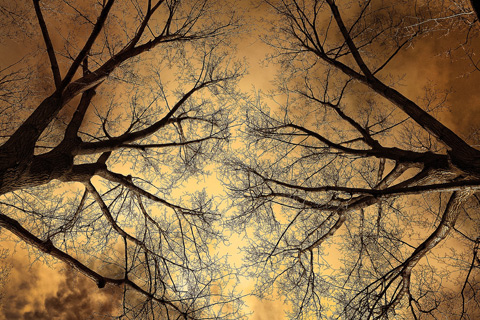
Trees get sick. Like any other living organism, a tree can fall ill for various reasons. If left to its own devices, it can eventually fall causing catastrophic damages.
When an otherwise healthy tree shows signs of illness or infestation, you must take action by eliminating the cause or calling on a certified arborist to evaluate the tree and offer a course of action.
The team of arborists at 72tree.com prepared a comprehensive list of 9 common tree health problems and their solutions.
Weather and Tree Health
Trees are affected by inconsistent weather patterns. The following demonstrates how weather impacts trees and how you can help them remain healthy.
1 – Drought:
One of the most common ailments of trees, symptoms of drought can be tricky. Sometimes, the signs won’t appear until as much as a year after the damage has been done. Those symptoms include:
•Drooping, wilting, and yellowing of leaves.
•Premature needle or leaf drop.
•Pronounced dieback.
•Thinning of the canopy.
•Deep cracks in the bark.
•Necrosis of leaves or browning of needles.
•Death of the tree.
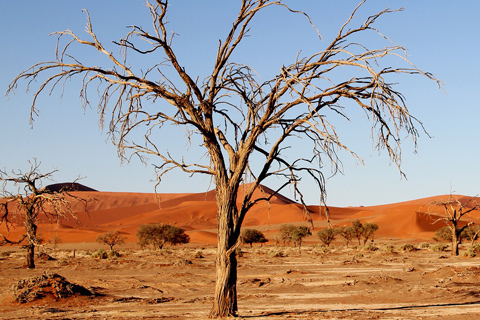
Solution 1 – For planting new trees, make sure they are appropriate for the USDA Hardiness Zone in which you are located. If your area experiences occasional or frequent droughts, seek drought-resistant species.
Solution 2 – Water your trees regularly. New trees will require a deep watering once a week for the first two years (to establish its roots). In addition to watering, add a 3-inch layer of organic mulch around the tree to help the soil retain its moisture.
After two years and through its adult life, trees are very capable of finding water sources. However, throughout dry summer months and near the end of fall, weekly deep watering and mulching will help prevent drought problems.
Solution 3 – Prune back all cracked, dead or weakened tissue. Without pruning these troubled areas, the tree will become vulnerable to infection and infestation. Call on an arborist when pruning removes more than 25% of the tree’s canopy or mass. They can assess the tree and offer a course of action.
2 – Winter Burn:
Also known as desiccation, winter burn occurs primarily in evergreens and causes a discoloration of the foliage. Effects of winter burn are more pronounced where the tree is exposed to the sun and wind. This affliction requires the presence of the following three factors:
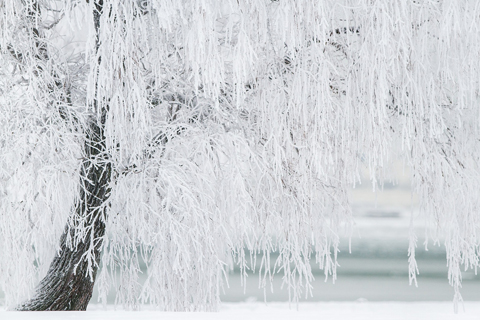
•Freezing temperatures
•Dry soil
•Wind
Solution – Provide your trees with weekly deep waterings through the end of fall and beginning of winter (before the ground freezes) and mulch the area of the root zone for the soil to retain moisture.
For trees that are highly exposed to the wind and sun, wrapping them with burlap will provide an effective barrier which can be removed as temperatures rise.
3 – Improper Pruning, Trimming, and Cutting:
There is a right way, and a right time to perform tree pruning, cutting, or trimming. When performed improperly, the tree may be left exposed to infection and infestation. When done at the wrong time, new growth may not have enough time to adapt before winter, further stressing the tree.
Solution – Know when to prune. Depending on the species of your tree, it may be better to prune in early spring, late fall, or even in the summer months. Use proper pruning or cutting methods when removing limbs, branches, or stems.
Watch this video to learn more about proper pruning techniques.
Tree Insect Infestation
For the most part, healthy trees can stave off insect infestations. However, when a tree’s health is weakened, or there is an increase in the insect population, no tree is off limits.
4 – Insects on Leaves and Bark:
Insects such as aphids, inchworms, bagworms, spider mites, lace bugs, and tree scale are common and relatively easy to manage.
Solution – Apply insecticidal soap, neem oil, or a horticultural oil directly on the area of the infestation.
5 – Boring Insects:
Insects such as the Emerald Ash Borer, Japanese Beetle, Southern Pine Beetle, and Ambrosia Beetle are more complicated to control. You can identify boring insect activity by seeing “sawdust” from their boring activity and the entry hole they create when entering the tree.
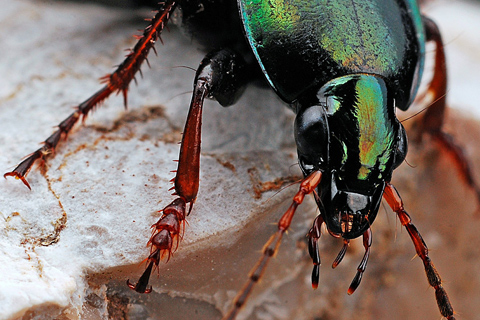
Note: Do not inject insecticides, poisons, or other substances into boring insect entry holes. The chemical may end up further damaging the tree leaving it more susceptible to infestation and death.
Solution 1 – Prune back branches and stems that have been infested and destroy them to prevent further spreading. If more than 25% of the tree’s foliage or mass must be removed, seek the assistance of a certified arborist.
Solution 2 – When the infestation is in the trunk of the tree, call an arborist to evaluate the damage and determine a safe approach to halting the infestation.
Solution 3 – Prevent infestations by keeping your trees healthy. When you hear about an outbreak in your area, treat your trees with a bark insecticidal spray to deter the insects from making your tree its host.
Tree Fungal Diseases
Most fungal diseases make their way into a tree through the roots and open wounds. Once a tree is widely infected, it becomes challenging to control the fungi and will often result in the removal of the tree.
6 – Fungal Infection (internal)
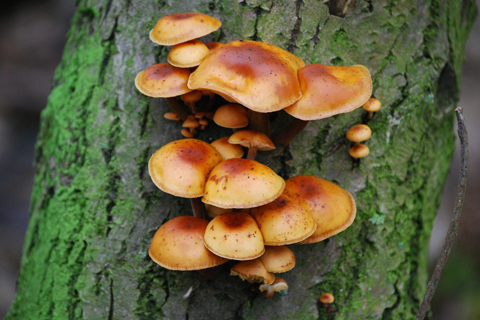
The most alarming sign of fungal trouble is when mushrooms grow on the trunk or branches. Since they require decaying matter to develop, there is a serious issue at play.
Note: The introduction of herbicides to a wounded tree or beneath the bark will only serve to accelerate the death of the tree.
Solution 1 – Prune back and destroy affected foliage, limbs, and branches. Again, when more than 25% of the tree’s foliage or mass must be removed, seek the assistance of a certified arborist. The removal of the tree may be the only way to keep your other trees from being infected.
Solution 2 – Properly prune your healthy trees (or have them pruned) to keep them healthy. A poorly pruned tree is more susceptible to both insect infestation and fungal disease.
7 – Fungal Infection (external)
The wind, birds or insects often carry spores of fungi and pathogens from tree to tree. Cankers, fire blight, rust disease, powdery mildew, and many others are common in the spring and summertime.
Solution – Carefully prune back and destroy affected foliage and apply a fungicidal spray to the affected and surrounding areas. Surrounding trees and shrubs should all undergo treatment as well.
Watch this video to learn about pathogens such as fire blight and cankers which affect tree bark and foliage.
Tree Problems Caused by People and Machinery
All of the threats mentioned above aside, people pose the most significant threat to a tree’s livelihood either by lack of knowledge or accident.
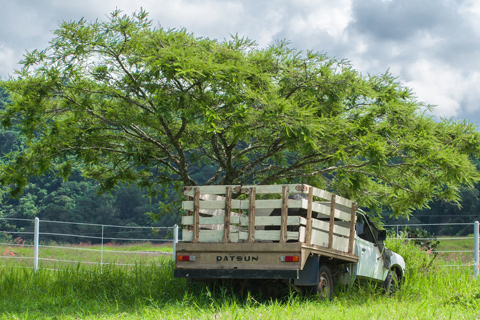
8 – Soil Compaction:
The land that surrounds a tree (especially under its canopy) contains the majority of the roots that draw water for the tree. These roots grow within the top 12 to 18 inches of soil. When this area is compacted, these roots suffocate and die, severely weakening the tree.
Trees compromised by soil compaction are at a heightened risk of toppling in a storm or severe weather event, as their roots are no longer effectively able to anchor them to the ground. Many times, no storm is required, the tree will eventually succumb to its own weight and fall on its own.
Solution – Never drive or park any vehicles underneath a tree’s canopy. Likewise, never store heavy equipment, or erect tool sheds under a tree.
In most municipalities nationwide, tree protection ordinances mandate that protective barriers be placed around trees on construction sites to deter such activities.
The majority of those same ordinances impose heavy fines and replanting requirements known as a recompense for damaged or removed trees.
9 – Lawn Mowers, Motorized Equipment, and Bark Damage:
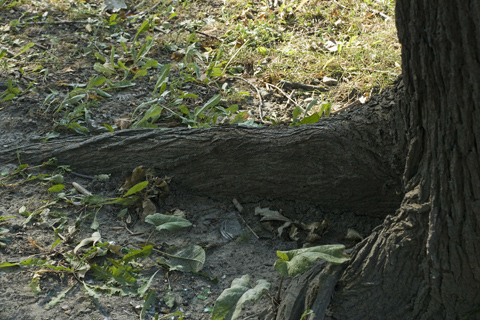
Below the bark of a tree and outer layer of roots, there is a thin layer of cells called the “phloem” which is the conduit for nutrients traveling up and down the tree.
When a tree’s bark is damaged, not only is the tree susceptible to infection and infestation, that flow of nutrients is interrupted and if the damage is around the majority or entirety of the trunk, the tree will be girdled and die.
Solution 1 – Do not allow lawn mowers and other equipment to damage protruding roots or the bark of the tree.
Solution 2 – For protruding roots, either raise the ground level to bury them, or carefully prune them. If you choose to prune the roots, call on a tree professional for detailed instruction or to do the job. Just cutting them out may result in the decline of the tree’s health and its death.
Solution 3 – If the bark of a tree is dried, cracked, or knocked loose, DO NOT remove it. Call an arborist to evaluate the tree’s situation.
Healthy Trees and Arborists
All arborists would agree that healthy, well cared for trees are capable of resisting most infestations and illnesses on their own. However, when a tree does present signs of trouble, knowing what to do can mean the difference between life and death for the tree.
Whether the troubles come from weather, insect, fungi, or people, the solutions are usually simple when detected and treated early. In many cases, to prevent the spreading of a pathogen or the demise of the tree, a certified arborist should be called in to assess the situation and determine a safe course of action.
When your trees show signs of trouble, doing nothing or hesitating to correct the problem may result in the decline of the tree’s health or even its abrupt death.
Sources:
https://www.treesaregood.org/treeowner/planthealthcare
http://www.missouribotanicalgarden.org/gardens-gardening/your-garden/help-for-the-home-gardener/advice-tips-resources/pests-and-problems/environmental/winter-injury/desiccation-or-winter-burn.aspx
https://www.arborday.org/trees/health/issues.cfm
Notice: Undefined variable: page in /home/vrxdg1855sn3/public_html/wp-content/themes/72tree/content.php on line 15
Notice: Trying to get property 'ID' of non-object in /home/vrxdg1855sn3/public_html/wp-content/themes/72tree/content.php on line 15
5 Tree Pests and Diseases to Avoid this Spring
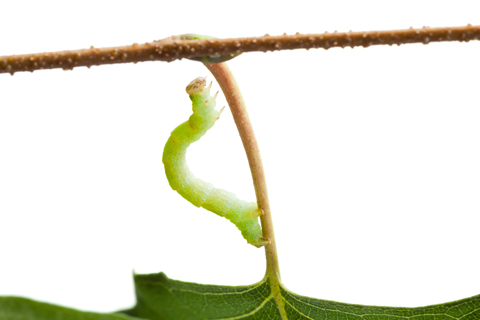
Spring has arrived and with the new season comes new tree problems. It isn’t just the flowers blooming, trees budding, and pollen everywhere; tree pests and diseases are coming alive as well.
Generally, when winter weather and lower temperatures are sustained throughout the season, pests and disease won’t pose much of a threat in the spring. This year however, winter weather and temperatures were relatively mild, favoring the spread of disease and increasing pest population. It’s just the beginning of the season, and there is great potential for tree damage this spring.
The arborist at 72 Tree, Seed & Land Co. identified 5 common tree killers, and methods to get them under control this spring. Also being discussed are routine tree and landscape inspections, pest and disease prevention, and ongoing tree care throughout the year.
3 Common Spring Tree Pests
While there are a wide variety of tree pests, the following have been singled out due to the extent of the damage they can cause. So take heed because, the damage often goes unnoticed until removal of the tree is necessary.
Bagworms – If the leaves on your tree are turning brown or the needles are falling off of your pine, the culprit may be bagworms. Your tree is their food, and as they consume, your tree is unable to produce vital nutrients to keep it healthy and alive.
These worms make a bag-like nest (thus the name) which is often mistaken for a pinecone. In the fall, they mate and each female bagworm is able to lay over 500 eggs that hatch in mid spring.
There are two effective ways of controlling bagworms. You can physically remove and destroy the “bags”, or apply a pesticide in the spring as they are hatching. Once you have confirmed that bagworms have invaded your landscape, you will likely need the help of a professional tree service to keep them under control.
Cankerworms – Also known as inchworms, cankerworms chew away at the foliage of your trees. There are two species of this pest “fall cankerworm” and “spring cankerworm” but don’t let the name mislead you, they both hatch in the spring and feed on the same trees.
The damage they inflict on trees is more stress related and potentially leads to dieback, borer damage, and even root decline. For a healthy tree, one year of cankerworm defoliation won’t necessarily result in the loss of the tree. However, multiple years of defoliation will weaken the tree, making it susceptible to other pests that can ultimately lead it to its death.
When there is a breakout of this pest, there are two principle treatments.
1) Banding the trees in the fall (the wingless females stick to the band and cannot reach the canopy to deposit their eggs) is one very effective measure.
2) The other is the use of pesticides shortly after the worms have hatched. This measure is only effective while the worms are small and should be monitored by an arborist to ensure proper control is achieved.
Southern Pine Beetle – (Dendroctonus frontalis) These boring tree killers are known as the most destructive forest insect in the southern states. The signs or symptoms of an infestation are severe dieback, browning, and eventual death of entire limbs, foliage, and the tree itself.
Once this beetle attacks and succeeds at making a tree its host, the adults emit a pheromone attracting other beetles to the tree. In a matter of days, a tree’s defenses can be overrun by thousands of beetles. As one tree becomes overpopulated, the beetles will seek out nearby trees to colonize, thus expanding their population and local infestation potential.
It is the older and weakened trees that are more susceptible to beetle infestation. Control is accomplished by promoting the health of your trees, and when there is a breakout, applying insecticides to the tree bark is an alternative.
If you have a tree affected or infested by southern pine beetles, you will need an arborist to help identify witch, and if measures can be taken to thwart the infestation.
2 Common Spring Tree Diseases
Throughout the lifecycle of a tree, it may be faced with a number of fungal invaders from its roots to its leaves. While a tree builds a natural resistance to these invaders, trees are not completely immune and can be severely debilitated. The following tree diseases are ones that should be addressed immediately after being diagnosed.
Fire Blight – (Erwinia amylovora) Is a contagious plant disease. Blight is a hard to control pathogen that robs plant and tree foliage of its nutrients, causing the blackening and death of that foliage. Fire blight differs from dieback in that it leaves behind the appearance that the foliage has burned. Thus the name.
Blight is most successful in the springtime, as temperatures and humidity remain ideal for its growth. As with other pathogens, it is spread from host to host by physical contact, insects, birds and other wildlife; be careful when working in the garden because even the tools used for landscape maintenance can transmit fire blight disease.
Moreover, there is no known cure for blight. Control is achieved by pruning and destroying the affected foliage and limbs. The use of pesticides can also aid to control the pest population. As stated, the proper cleaning of equipment after use is helpful to avoid its proliferation. While the planting of resistant or tolerant species is an effective and proactive approach to overcome this disease.
NOTE: When cleaning garden and landscape equipment after handling diseases such as blight, applying a bleach solution (1 part bleach to 4 parts water) to your tools is recommended to neutralize the pathogen.
In the following link we discussed preventing fire blight tree disease in more depth, so check it out for more solutions and detail of this devastating disease.
Heart Rot – Heart rot is a fungal disease causing the softening and decay of the wood found at the center of a tree’s trunk and branches. When you see mushrooms or fungus conks attached to the trunk or branches of a tree, it can be a strong indicator that heart rot is present within the tree.
Fungi enter the tree through damaged bark or poorly pruned ares, move to the heartwood, and begin the process of decay. Softening of the heartwood leaves trees structurally weak and prone to collapse or breakage.
Hardwood trees are affected by heart rot on a global scale, and is extremely difficult to prevent. However, if a tree is growing vigorously, it may be able to isolate the affected portion of itself through a process called compartmentalization.
Control of this destructive disease may be achieved by keeping your tree healthy through proper pruning techniques, annual inspections by an arborist, and post storm maintenance and pruning.
Routine Tree and Landscape Inspections
Tree and landscape inspections start with you. When you’re out mowing, watering, pruning, or playing in your yard, observe the plants, shrubs, and trees. Look for insect infestations, discoloration in the foliage, and dieback of the limbs and crown. For more on dieback and signs of a diseased tree, visit 72tree.com/signs-diseased-tree-dieback-suckers-water-sprouts/
Once a year, hire an arborist to thoroughly inspect your trees and the plant life in your yard. They are trained to spot potential health issues, and implement the best solutions to save and/or extend the lives of your plants.
Prevention and Continued Care
The best preventative maintenance for your trees and plants is the consistent and continued care that you provide them. Healthy plants have the strength to develop defense systems that ward off both pests and disease.
Proper and timely pruning, watering, and fertilizing will help your trees reach maturity faster and in a stronger and more resistant way.
Controlling Pests and Disease All Year
Every pest has its season and every season has its pests. As you have probably gathered by now, the best way to control pests and disease is by keeping your trees, shrubs, and plants healthy through remaining proactive and aware of their state.
Pest control will help in stopping the spread of pathogenic fungi and bacteria, as well as curbing some of the more voracious insects. Fungicides will also help keep many of the pathogens away from your landscape’s ecosystem.
Keep your trees healthy this spring and for years to come by knowing what to look for and which steps to take. And when something strange pops up, call on your local arborist to address and get it solved.
Notice: Undefined variable: page in /home/vrxdg1855sn3/public_html/wp-content/themes/72tree/content.php on line 15
Notice: Trying to get property 'ID' of non-object in /home/vrxdg1855sn3/public_html/wp-content/themes/72tree/content.php on line 15
My Tree is Dying from the Top Down
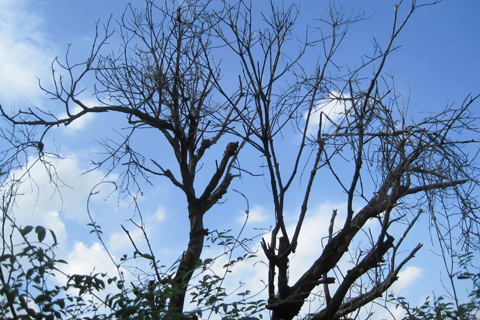
What causes a tree to die from the top down? A common reason for a tree to die from the top down or from its outer limbs is drought. Even with reasonable rainfall, your tree may not be getting the water it needs to thrive and survive.
When a tree begins to deteriorate from the top down, this condition is also known as dieback. Dieback is the gradual death of tree branches, foliage, and/or limbs starting at the tips (extremities) and moving inward toward the trunk. Dieback, as mentioned above may result from drought. However, there may be a variety a variety of causes contributing to the gradual death of your tree.
The following will help you to identify what is causing dieback, the options available to save the tree, and the actions you can take to prevent the tree’s death.
What Can Cause Dieback from the Top Down?
In order to identify the cause of dieback, you need to know what you are looking for. The following are common reasons and symptoms when tree health declines.
Drought – Symptoms include the wilting or discoloration of leaves, limb, twig, and branch dieback, as well as the death of roots. Trees suffering from drought are very likely to be affected by insects, disease, or both.
Soil Imbalance – Soil is composed of minerals, organic and inorganic matter, water, air, and has an acidic or alkaline pH level. When an imbalance of these levels occurs, nutrients needed for the tree’s survival may not be absorbed. This can certainly lead to dieback and death of the tree if not addressed.
A sure sign of soil trouble is the absence of worms, plant growth, and small insects. “Life” should be detected in your soil, if not your soil’s health needs attention.
Insect Infestation – Invasive insect species also cause or accelerate dieback. When trees are stressed, they produce more amounts of nitrogen, potassium and phosphorus. This in turn makes them more attractive to invasive insects that feed off them.
As an infestation grows, the tree becomes more stressed and in turn, produces more of the chemicals – attracting more insects. This process can become a self-reinforced loop, and the initial stressors now combined with the infestation will eventually lead to the death of the tree if not treated promptly.
NOTE: While trees have adapted their defenses and healing processes over the millennia, it is these same adaptations that may feed an insect infestation.
What Options Do I Have to Save My Tree?
For each of the causes listed above, there is a specific course of action to halt or even reverse it. Once the cause is identified, the following simple treatments may help to save your tree.
Drought Treatment – During dry seasons or when rainfall is scarce, give your trees a thorough watering once a week. Make sure that the soil is soaked to a depth of at least twelve inches. Mulching around your trees base will slow the evaporation process and help the soil and tree retain moisture.
Soil Imbalance Treatment – While calling in a Certified Arborist may be the best option here, you are perfectly capable of getting a soil test kit from your local nursery or home improvement store (gardening department). Use the kit to determine if there is an imbalance for the species of affected tree(s), then seek appropriate soil treatments to return the soil to a healthy composition.
Insect Infestation Treatment – Once an infestation is confirmed, insecticides, traps, and oil can be used to kill the existing insects and prevent further infestation. Read this 72tree.com/using-dormant-horticultural-oil-treat-tree-insect-infestations/ for more on using and applying oils to treat insect infestations.
It is important to note that insect infestations are typically the result of a tree already stressed or in bad health. Once the infestation has been dealt with, begin looking for other stressors that may have lead to the weakening of the tree’s health.
How Do You Save a Dying Tree?
When dieback occurs, saving your tree will involve pruning or trimming off the dead parts of the tree, and identifying the reason that the dieback occurred. Once identified, treat it. If it is an infestation that is threatening other trees and plants, you may have to make the decision to completely remove the tree to prevent further contamination and damage.
Proper Treatment and Prevention – Once you have treated the cause of your tree’s dieback, understand that you can save a dying tree by simply paying attention to it through the seasons. Your tree will show signs of stress, and once you detect it, consider it a call to action.
It is equally important to establish and follow seasonal maintenance and care. Bringing in a Certified Arborist or reputable tree service to inspect your trees and landscape will help give you the upper hand in keeping your trees healthy!
